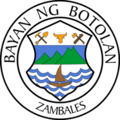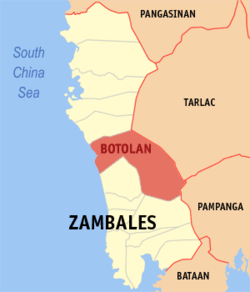Top Qs
Timeline
Chat
Perspective
Botolan
Municipality in Zambales, Philippines From Wikipedia, the free encyclopedia
Remove ads
Botolan, officially the Municipality of Botolan, is a municipality in the province of Zambales, Philippines. According to the 2024 census, it has a population of 70,340 people.[6]
Remove ads
Etymology
The name Botolan came from the a native variety of banana common in the area called "Boto-an". The word "Boto-an" is a Sambal word which combines the word botol which means "seeds" and the locative prefix -an, referring to a place with many seeded bananas.[7]
History
The municipality was founded by Spanish Governor-General Juan de Salcedo in 1572.[1] It is known for its relatively sizeable Aeta population, wide gray sand beaches, and its proximity to Mount Pinatubo.
The town was founded by a Kapampangan from Mabalacat in 1819.[8]
Geography
Summarize
Perspective
Located just south of the provincial capital of Iba, Botolan has the largest land area of the municipalities in Zambales.
Botolan is 7 kilometres (4.3 mi) from Iba, 71 kilometres (44 mi) from Olongapo, and 197 kilometres (122 mi) from Manila.
Barangays
Botolan is politically subdivided into 31 barangays, as indicated below.[9] Each barangay consists of puroks and some have sitios.
- Bancal
- Bangan
- Batonlapoc
- Belbel
- Beneg
- Binuclutan
- Burgos
- Cabatuan
- Capayawan
- Carael
- Danacbunga
- Maguisguis
- Malomboy
- Mambog
- Moraza
- Nacolcol
- Owaog-Nibloc
- Paco (poblacion)
- Palis
- Panan
- Parel
- Paudpod
- Poonbato
- Porac
- San Isidro
- San Juan
- San Miguel
- Santiago
- Tampo (poblacion)
- Taugtog
- Villar
Climate
Demographics
In the 2020 census, the population of Botolan was 66,739 people,[16] with a density of 91 inhabitants per square kilometre or 240 inhabitants per square mile.
Remove ads
Economy
Poverty incidence of Botolan
10
20
30
40
2000
33.79
33.79
2003
13.95
13.95
2006
22.40
22.40
2009
17.40
17.40
2012
23.73
23.73
2015
22.65
22.65
2018
12.75
12.75
2021
30.74
30.74
Source: Philippine Statistics Authority[17][18][19][20][21][22][23][24]
Government

Elected officials
Municipal officials (2025-2028)
- Mayor: Jun Omar Ebdane
- Vice Mayor: Atty. Ed Perez
- Members of the Municipal Council:
- Doris Ladines
- Eddie Daos
- Lance Lim
- Angel Diesta
- Jay Dilag
- Fernando Igrobay
- Arthur Daria
- Gregorio Jaring
Tourism
Summarize
Perspective

The barangay of Binoclutan is the "Beach Capital" of Botolan, featuring several first class resorts. The area is a habitat of sea turtles, as is all of the Zambales coastline. Olive Ridley, Green turtles and Hawksbill turtles nest along the beaches of Botolan every year between September and January. A turtle hatchery located is located in Binoklutan. The area also has many other attractions, beach resorts, waterfalls, hiking paths, views of the lahar fields left by the 1991 eruption of Mount Pinatubo, and views of Mount Pinatubo itself.
The Fiesta Poon Bato, held January 23–24, is a religious festival that attracts up to 500,000 devotees. Features include cultural dancing from local Aeta tribes in the town plaza on the first night.
The Domorokdok Festival, held May 3–4, includes street parades, street dancing, a beauty pageant and displays of Botolan products and industries.
Ina Poon Bato

The Ina Poón Bató is a purportedly miraculous, syncretised image of the Blessed Virgin Mary.[25] Legend has it that before the arrival of the Spanish in the area sometime in the 17th century, local Aeta peoples had discovered a carved wooden statue on a large rock and began worshipping the image. On the arrival of Recollect missionaries in 1607, the natives associated the statue with the Roman Catholic depictions of the Virgin Mary, and the image was subsequently Christianised as Ina Poonbato (Our Lady of Poonbato) .[25] The original image was previously in the Recollect missionaries’ custody. During the Philippine Revolution, the Filipino revolutionaries took the image and enshrined it in an Aglipayan Church.
The Catholic image was canonically blessed by Pope John Paul II in 1985 at a ceremony in Vatican City.[26] After the 1991 eruption of Mount Pinatubo destroyed the original village of Poonbato, the patio image (which was found intact and buried chest-deep in lahar)[27] and its shrine were moved to the nearby resettlement area of Loob-Bunga.[28] The feast of Ina Poón Bató is celebrated every late January, with devotees flocking to the original image inside a chapel belonging to the Aglipayan Church, and the 1976 replica enshrined in the Catholic chapel.[27]
Remove ads
Education
Summarize
Perspective
There are two schools district offices which govern all educational institutions within the municipality. They oversee the management and operations of all private and public, from primary to secondary schools.[29]
Primary and elementary schools
- Alao Elementary School
- Baquilan I Resettlement School
- Baquilan II Resettlement School
- Batonlapoc Elementary School
- Belbel Elementary School
- Beneg Elementary School
- Bihawo Elementary School
- Binoclutan Elementary School
- Botolan South Central School
- Burgos Elementary School
- Casa Mambog Learning Center
- Danacbunga Elementary School
- Fountain of Blessings Development Center
- Kainomayan Village Elementary School
- Loob-Bunga I Elementary School
- Loob-Bunga II Elementary School
- Loob-Bunga III Elementary School
- Moraza Elementary School
- New Taugtog I Elementary School
- New Taugtog II Elementary School
- Owaog-Nebloc Elementary School
- Paitan Elementary School
- Palis Elementary School
- Panan Elementary School
- Paudpod Elementary School
- Parel Elementary School
- San Isidro Elementary School
- Sta. Monica Parochial Institute (Elementary)
Secondary schools
- Bancal Integrated School
- Bangan-Capayawan Integrated School
- Baquilan Resettlement High School
- Beneg National High School
- Botolan National High School
- Botolan North Integrated School
- Bucao Integrated School
- Dojoc Balite Integrated School
- Cabatuan Integrated School
- Carael Integrated School
- Lakas High School
- Loob Bunga High School (Resettlement School)
- Lyceum of Central Luzon
- Lyceum of Western Luzon
- Maguisguis Integrated School
- Mambog Integrated School
- Nacolcol Integrated School
- New Taugtog National High School
- Panan National High School
- Poonbato Integrated School
- Porac Integrated School
- San Juan Integrated School
- Santiago Integrated School
- Sta. Monica Parochial Institute
- Villar Integrated School
Higher educational institutions
- Columban College
- Micro Asia College of Science and Technology
- Mother Theresa Collegio de Zambales
- Technological College
Remove ads
References
External links
Wikiwand - on
Seamless Wikipedia browsing. On steroids.
Remove ads






